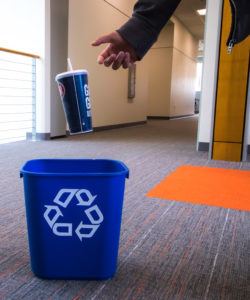The university has been named a Green Power Partner by the Environmental Protection Agency (EPA) and has become a member of The Association for the Advancement of Sustainability in Higher Education (AASHE).
Paul Matthews, director of facilities, said these accolades show that the university and the facilities department are dedicated to making campus more environmentally friendly.
Any business or university can become a Green Power Partner through the EPA by showing that a certain percentage of the energy they use is green. Capital achieves this by purchasing renewable energy credits.
According to Matthews, the university purchased a renewable energy credit this year in an effort to reduce our carbon footprint and support green energy. Matthews says the credit works similarly to buying stock in a company, as the money goes back to helping build and sustain renewable power plants that supply the grid.
Many universities and businesses use these credits to support renewable energy without building a wind farm or using solar panels on their campus. While our credit was purchased specifically for wind energy, there are also credits specifically for other types of green energy available.
“Of the 15 million kilowatt-hours that we utilize, 790,000 of it is through wind,” Matthews said.
The university’s environmental sustainability committee voted that Capital would join AASHE this year. Being part of AASHE allows the university to see what other schools are doing to reduce their carbon footprint and gives them ideas and tools for projects that can be done on campus.
Being part of this association has already given Matthews and the facilities team the idea to build a natural park on Sheridan between the houses and the Capital Commons. This space will feature trees, native Ohio wildflowers, and benches for students to sit and enjoy.
Matthews said facilities is already working to reduce the university’s carbon footprint by changing lighting around campus to LED, which wastes much less power than traditional bulbs.
By using less power, the university receives incentives from AEP and reduces its carbon footprint. Facilities also introduced a new building automation system this year, which allows the facilities department to deal with small issues in residence halls and buildings remotely. This system saves manpower as well as reduces energy waste.
Other projects, such as the composting and recycling programs already on campus, are already working to reduce the university’s impact on the environment.
The university has most recently been named a Water Quality Partner by the Franklin Soil and Water Conservation District on Jan. 18, meaning they have pledged to try to keep water that returns into the water system free of contaminants.
Being part of these programs is an effort for the university to continue following the United Nations Paris Climate Agreement, Matthews said, even though President Trump announced in June 2017 that the U.S. would leave the agreement.
This action made the U.S. the only country in the world in opposition to the terms of the Paris Agreement. The U.S. is still required to carry out the terms of the agreement, which aim to reduce greenhouse gas emissions and stop the rising of global temperatures, until 2020.
“We’re not ignoring the environment,” Matthews said. “We know that we should be good stewards and we always want students’ help.”


